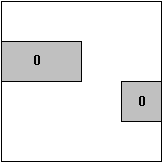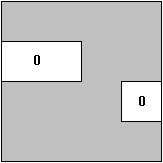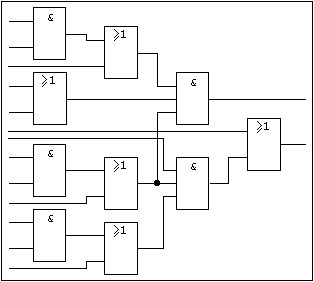 |
 |
DNF (AND/OR-Form) - SOP |
| Transformation using the "de Morgan" Theorem results in: | ||
 | (NAND-Form) | |
| Contents | Previous Chapter | Next Chapter |
Fundamental Description of Boolean Functions
In order to simplify (minimize) a Boolean function using Karnaugh Diagrams (K-Maps), the combination (grouping) of fields (boxes, squares) is necessary. This process can be applied to the 0-fields or the 1-fields. Furthermore, to characterize these fields the arguments or their complements can be used.
As can be seen, a multitude of combinations can be distinguished. These possibilities will be summarized here.
Describing a Boolean function using 1-fields:
 |
 |
DNF (AND/OR-Form) - SOP |
| Transformation using the "de Morgan" Theorem results in: | ||
 | (NAND-Form) | |
Describing a Boolean function using the complement of 1-fields:
 |
 |
(OR/AND-Form) |
| Transformation using the "de Morgan" Theorem results in: | ||
 |
(NOR/OR-Form) | |
Describing a Boolean function using 0-fields:
 |
 |
(AND/OR-Form) |
| Transformation using the "de Morgan" Theorem results in: | ||
 |
(NAND/AND-Form) | |
Describing a Boolean function using the complement of 0-fields:
 |
 |
CNF (OR/AND-Form) - POS |
| Transformation using the "de Morgan" Theorem results in: | ||
 | (NOR-Form) | |
Considering two-level implementations (of circuits), the AND/OR-Form (DNF) and the OR/AND-Form
(KNF) are of special importance, because they represent very straightforward description forms.
Definition:
A multilevel network with an arbitrary number of inputs and outputs is called an AND/OR-network when on any arbitrary signal path between an input and an output AND and OR functions are alternatingly passed.
Example:

Figure 2.29: Typical AND-OR-Network.
Considering practical applications, circuits implemented with NAND or NOR gates, respectively, are more important than AND/OR networks. The main reason for this is a technological one: basic NAND and NOR gates can be manufactured more easily.
Therefore the transformation from AND/OR/NOT-circuits to NAND/NOR-circuits is of very high importance. This transformation follows again the "DeMorgan" Theorem and can therefore be formulated as a simple three-step process:
Transformation Example (two-level networks):
AND/OR → NAND:
 | (2.11) |
OR/AND → NOR:
 | (2.12) |
| Contents | Previous Chapter | Next Chapter |